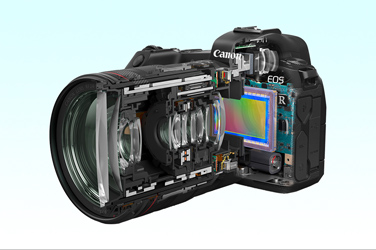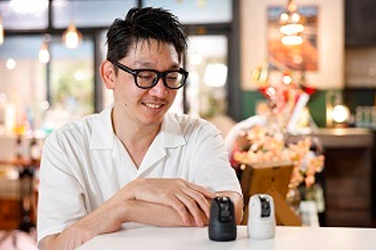

A Mirrorless Camera for Snapping the Moments You Want to Capture
EOS R3
The EOS R3 is a full-frame mirrorless camera with superb high-speed and autofocus performance. In the pursuit of unprecedented visual expression, this camera is equipped with cutting-edge technologies. With a future-oriented development approach when it comes operational feel and picture quality, we satisfy the wishes of both professionals and enthusiast users with a reliability obtained through strict quality evaluations.
October 16, 2023
Our Unique Autofocus Technology Delivers Moments Beyond Perfect
As digital cameras have evolved, their ability to handle subjects and settings that are difficult to capture has increased. However, there is no end to the desires of photographers who want to ” take the photo that is more like what they envision“. To make that happen, Canon has been giving thought to what sorts of functions would lead users to expand their photographic horizons and is creating new technologies one after another.

EOS R3
One is autofocus (AF), which is a technology that communicates the intentions of the photographer to the camera more quickly and reliably than humanly possible. Released in 2021, the EOS R3 is equipped with an eye control function that precisely focuses on the spot that the photographer sees with their eyes. To detect the line of sight of the photographer requires that their pupils be detected with great precision. Canon has improved quality through trial and error in order to come up with a function that more people will be able to use; for example, to reduce the impacts on the precision of pupil detection of eyelids, eyelashes, camera setup, and whether or not someone is wearing glasses, Canon has observed the eyes of various people and how photographers look through the camera viewfinder.

Irradiation of infrared LED detects pupils precisely.
An eye control function that precisely focuses on the spot that the photographer sees with their eyes.
*This function can be used only when shooting still images. It cannot be used during movie recording.
*In order to view videos, it is necessary to consent to the use of cookies by our website. If the videos are not displayed, please click the "Cookie Settings" and accept cookies.
With regard to the subject detection function that can detect the subject, the camera makes use of deep learning technology that uses an enormous amount of data to train its AI. Along with detectable subjects and conditions having been enhanced, measures have been added and improved to deal with scenes that previously were difficult to handle. This is currently the most advanced technology in Canon’s camera development, and Canon is focused on further advances that will make it possible to capture the scenes that users have in mind, such as by combining this technology with eye control functions to make it even easier to use.

Even fast-moving subjects such as animals or athletes can be detected
Expanded Possibilities for Handheld Photography through Image Stabilization Achieved with Cooperative Control
Like not being able to get in focus, another thing you want to avoid is camera shake. With the EOS R5 (released July 2020), Canon has achieved the high level of image stabilization that significantly outperforms DSLR EOS systems with 8.0 Stops *1 of image stabilization. Canon achieved this by developing “cooperative control” image stabilization for both the lens and camera body. This system can eliminate all five types of camera shake.*2
Cooperative control optimizes the correction effect by changing the amount of correction between the lens and body according to the photographing operation. In this system, a lot of information needs to be exchanged at high speeds. One of the elements that made cooperative control possible is high-speed communication between the lens and the body. Canon has long been refining its mirrorless camera RF mount communication technology in anticipation of the system evolution. The entire EOS R system supports photographers so they can take photos that satisfy them even with a single, handheld camera regardless of how bright or dark conditions may be.

Without image stabilizer

With image stabilizer
- *1 When using RF24-105mm F4 L IS USM, f=105mm Yaw(up and down axis rotation)/Pitch(left and right axis rotation) direction, CIPA standard compliant
- *2 5 axes of shift shake (up, down, left, and right), angle shake (up, down, left, and right), and rotation shake
Using Simulation Technology and Uncompromising Quality Assessments
By using the simulation technology on a variety of projects, Canon has improved the precision and speed of development, thanks for example to being able to process previously impossible analyses that couldn’t be at high speeds, and manufacturing is also being made more efficient. Previously, Canon used physical prototypes to carry out such tests as dropping and measuring heat generation in the body, but now these can be simulated at the design stage. The image stabilizer operates based on the principle of electromagnetic drive, and now the impact of magnetic force on the image sensors, for example, can also be checked using the simulation. Not only does this lead to quality improvements, but by shortening development time, it also makes it possible to quickly respond to photographers’ demands.
Our know-how in camera design is supported by the accumulation of technologies over out long history. For example, the knowledge built up when we developed film single-lens reflex cameras is being put to use in judging how many millimeters was the optimal thickness for the magnesium alloy used in the exterior body and what sealing materials were need to achieve the desired water-resistant performance. For tests that could not be simulated, and had to be done by hand, such as checking durability by spinning a dial over and over again, we have created robots to automate such tasks.
To deliver even better products to users, the quality control and development departments join together at the prototyping stage to make repeated evaluations and take countermeasures. In particular, quality assessments for picture quality and autofocus are rigorous, and if those high hurdles are not overcome then the product cannot move on to the next process. Development continues ceaselessly to the very end under the policy that we will not release a product until the target specifications have been achieved, such as getting high quality of the picture even with high sensitivity and getting autofocus to focus even in complete darkness using ultra-high sensitivity.


Sealing materials for preventing intrusion of water and dust
Making the Most of Accumulated Technologies and Continuing to Create Cameras that Satisfy Demands
The EOS R3 was developed with the goal of expanding the range of photos that could not be taken before. A variety of departments throughout the company combined component technologies to produce a camera that could satisfy the needs of both professionals and enthusiasts. We added a variety of appealing features such as a lighter-weight body compared to EOS 1D series, a super high-speed continuous shooting function, and an adjustable LCD monitor, and offered a new style of photography for mirrorless cameras.
Another Canon strength is having a long-running support system developed through our work with major sporting events and the like. We aim for zero downtime and delivering a speedy response so photographers in the field don’t have to stop their work for repairs and adjustments. The information we get is used to improve the EOS R3 and other future camera development. In recent years, we have also increasingly been able to respond to feedback with improvements to our firmware (the software that operates the camera and lenses) and have added functions. By being able to respond to demands quickly and precisely, we have achieved a high degree of reliability.
In order to come up with the necessary functions, Canon thinks about what might lie years down the road and then develops and formulates systems of component technologies. Technology development is carried out in a variety of departments, and target specifications are determined after considering how convenience for the target users will increase with the inclusion of what sorts of functions. Canon’s component technologies cover a broad range, resulting in an environment where it is easy to realize ideas. Another strength is that the research departments like R&D that span the entire company are closely tied together. The very fact that we have these component technologies and simulation technologies allows us to develop cameras with uncompromising quality that can be relied on. Furthermore, the database that the camera business department has results in greater accuracy in our simulations.
Expanded uses are foreseen for cameras in such fields as medicine, space, and agriculture. With our goal of creating cameras that capture images that previously were impossible, Canon will continue to expand the possibilities of visual expression, sustained by the accumulation of technologies developed throughout the company and feedback from a wide range of users.




